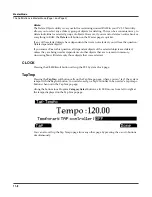
10-4
MIDI Mode
The RECEIVE Page
Basic Channel
The basic channel determines which channel will always be available to receive MIDI
information. Depending on the MIDI receive mode (below), the Basic channel may be the only
receiving channel, or one of several.
MIDI Receive Mode (MIDI Mode)
The MIDI Mode parameter determines the MIDI receiving capabilities of the PC3. When set to
Omni
, the PC3 responds to incoming MIDI events on all MIDI channels, and plays them on the
current channel. This is normally used for diagnostic purposes only.
At a setting of
Poly
, the PC3 responds only to events that are sent on the same channel as the
PC3’s current MIDI channel (the one displayed on the top line of the Program-mode page). In
Poly mode, the currently selected channel is always the basic channel, so if you change channels,
the basic channel changes accordingly.
With a value of
Multi
(the default), the PC3 responds to events on all active channels. This is the
mode you’ll use when you’re driving the PC3 with a sequencer, since you can play a different
program on each channel. At this setting, you can turn individual channels on and off (on the
CHANNELS page, described later in this chapter).
All Notes Off
If this parameter’s value is set to
Normal
, the PC3 responds to All Notes Off messages received
over MIDI.
Ignore
causes these messages to be ignored. If you’re using a Roland product as a
MIDI controller for your PC3, you’ll want to set the value of this parameter to
Ignore
. This is
because some older Roland products occasionally send an All Notes Off message when no keys
are held down—even if you’re sustaining notes with a pedal. You might find all your sustains
missing from your sequence, for example, if you’re driving your PC3 from one of Roland’s
hardware sequencers. Setting this parameter to
Ignore
takes care of this problem.
Regardless of the setting for this parameter, the PC3 always responds to its own
Panic
button by
shutting off all active notes and controllers.
Program Change Mode (PrgChgMode)
This determines how the PC3 responds to program change commands received via MIDI. See
Program Change Formats
on page 10-7 for an explanation of the various values available for this
parameter.
Velocity Map
The velocity map applies a preset curve to incoming velocity messages. It maps incoming
velocity levels to new levels that correspond to the eight dynamic levels used by the VTRIGs
and keymaps for velocity level selection. Normally you’ll leave this set to
1 Linear
. Adjust this
parameter’s value only when you need to alter the PC3’s response to the velocity messages from
a MIDI controller, for example, if you’re getting too much or too little volume when you play, or
when a sequencer is driving the PC3.
Pressure Map
Like the velocity map, this determines how the PC3 responds to incoming pressure (aftertouch)
messages.
System Exclusive ID (SysExID)
The SysExID parameter differentiates between more than one MIDI device of the same model.
You won’t need to change the default setting of 0 unless you have multiple PC3s (or K2600s,
K2500s, or K2000s) receiving SysEx messages from a single source. In that case, make sure each
Summary of Contents for PC3
Page 24: ...1 6 Introduction Options ...
Page 50: ...4 4 The Operating Modes Using the Modes ...
Page 174: ...7 54 Setup Mode The Utility Soft Buttons ...
Page 178: ...8 4 Quick Access Mode Making Your Own QA Banks ...
Page 204: ...9 26 Effects Mono Algorithms ...
Page 266: ...A 2 MIDI Implementation Chart ...
Page 308: ...Index x ...
















































